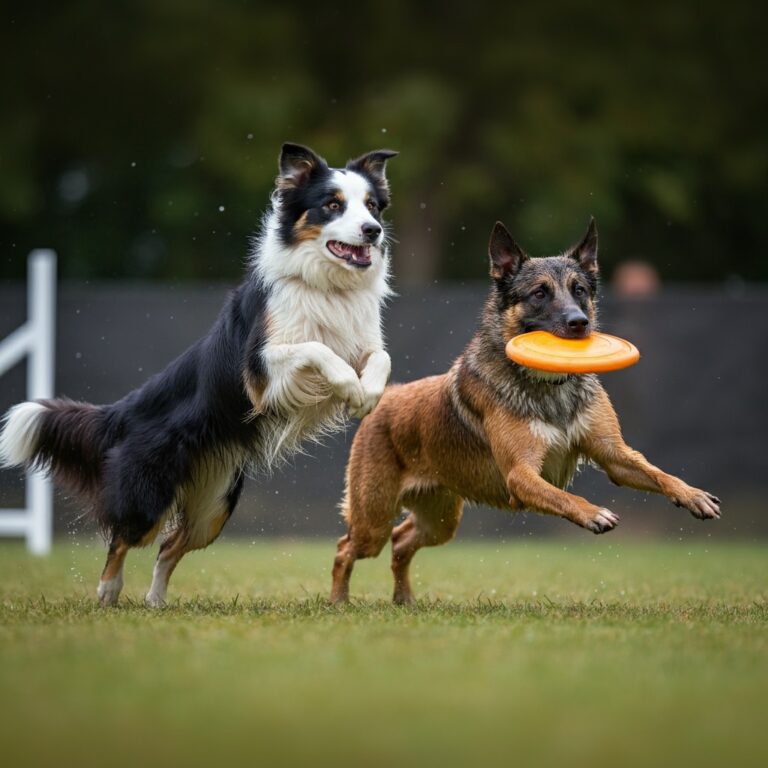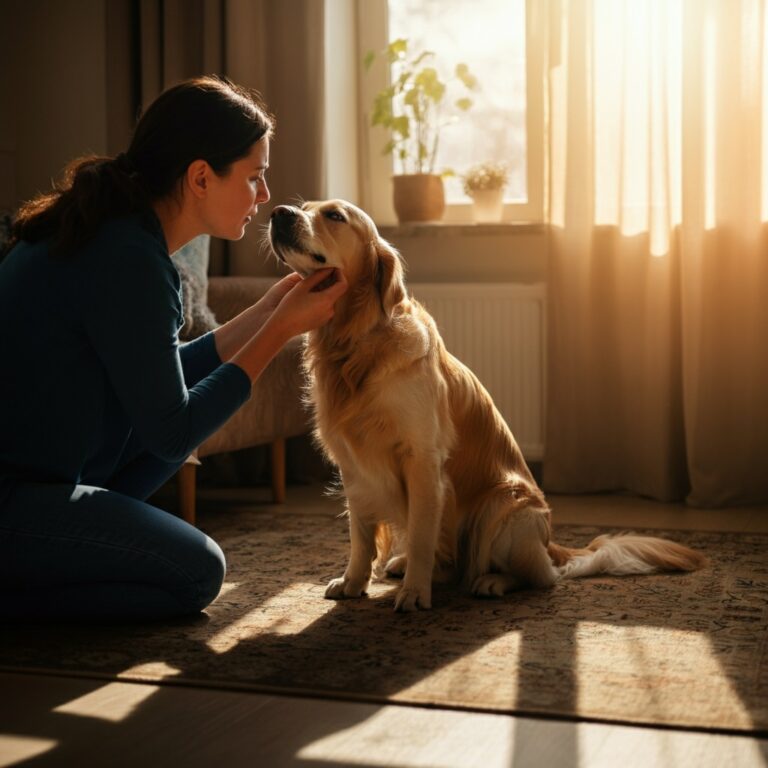
Have you ever wondered what the world looks like through your dog’s eyes? Many pet owners assume their furry friends see the world in black and white, but this common misconception has persisted for far too long. The truth about canine vision is far more fascinating and complex than most people realize.
Dogs do see colors, but their visual experience differs significantly from ours. Understanding how your dog perceives the world can help you choose better toys, create a more enriching environment, and deepen your bond with your four-legged companion. This post will explore the science behind dog vision, debunk common myths, and provide practical insights for dog owners who want to see the world from their pet’s perspective.
The Science Behind Canine Color Vision
To understand what colors dogs can see, we need to examine the structure of their eyes. Like humans, dogs have specialized cells called cones in their retinas that detect color. However, the number and type of these cones differ significantly between species.
Humans have three types of cones that detect red, green, and blue light wavelengths. This trichromatic vision allows us to see millions of color combinations across the visible spectrum. Dogs, on the other hand, have dichromatic vision with only two types of cones.
How Dog Eyes Process Color
Dogs possess cones that are most sensitive to blue and yellow wavelengths of light. This means they can distinguish between various shades of blue and yellow, but they struggle to differentiate between red and green. To a dog, red objects appear yellowish-brown, while green items look yellow or beige.
The peak sensitivity of canine cones occurs at wavelengths around 429 nanometers (blue) and 555 nanometers (yellow-green). This dichromatic vision is similar to red-green colorblindness in humans, affecting roughly 8% of men and 0.5% of women.
Beyond Color: Other Aspects of Dog Vision
While dogs may see fewer colors than humans, their eyes excel in other areas. Dogs have superior night vision due to several anatomical advantages:
Tapetum Lucidum: This reflective layer behind the retina acts like a mirror, bouncing light back through the eye for a second chance at detection. This structure causes the characteristic glow you see in dog eyes during nighttime photos.
Larger Pupils: Dogs can dilate their pupils wider than humans, allowing more light to enter the eye in low-light conditions.
More Rod Cells: Dogs have a higher concentration of rod cells, which are responsible for detecting motion and seeing in dim light. This abundance of rods comes at the cost of fewer cone cells for color detection.
Debunking the Black and White Myth
The persistent belief that dogs see only in black and white likely stems from early 20th-century assumptions rather than scientific evidence. For decades, researchers and pet owners alike accepted this myth without proper investigation.
Modern research using behavioral studies and electroretinography has definitively proven that dogs can distinguish between certain colors. Studies have shown that dogs can be trained to differentiate between colored objects, demonstrating their ability to perceive color differences.
What This Means for Dog Owners
Understanding that your dog sees some colors changes how you might approach various aspects of pet care:
Toy Selection: Blue and yellow toys will stand out more clearly to your dog than red or green ones. A bright blue ball will be much easier for your dog to spot in green grass than a red one.
Training Equipment: Consider using blue or yellow training equipment, as these colors will be more visible and distinguishable to your pet.
Safety Considerations: When choosing collars, leashes, or other safety equipment, blue and yellow options may be more noticeable to your dog.
The World Through Your Dog’s Eyes
Imagine walking through a park where the green grass appears yellow-beige, red flowers look brownish-yellow, and blue elements maintain their vibrant appearance. This altered color palette represents your dog’s visual experience of the same environment.
Brightness and Contrast
Dogs perceive brightness differently than humans. They see best in lighting conditions equivalent to human dawn or dusk. This crepuscular vision serves them well, as many of their wild ancestors were most active during these transitional periods.
The contrast sensitivity in dogs also differs from humans. They excel at detecting subtle differences in brightness and shadow, which helps them spot movement and navigate in low-light conditions.
Motion Detection
While dogs may miss some color details, they excel at detecting motion. Their eyes can perceive movement at distances where humans would see only static objects. This enhanced motion detection stems from their higher concentration of rod cells and serves as a crucial survival mechanism.
Continues after advertising
Practical Applications for Dog Owners
Understanding canine color vision has practical implications for pet care and training:
Choosing the Right Toys
Select toys in colors your dog can easily distinguish. Blue and yellow toys will provide the best visual contrast against most backgrounds. Avoid relying solely on red or green toys, as these may blend into the environment from your dog’s perspective.
Creating an Enriching Environment
When designing your dog’s living space, consider incorporating blue and yellow elements. These colors will be more stimulating and engaging for your pet. However, remember that dogs rely heavily on scent and texture, so color is just one factor in environmental enrichment.
Training Considerations
Visual cues used in training should account for your dog’s color vision. Blue and yellow markers, flags, or equipment will be more effective than red or green alternatives. However, dogs often rely more on shape, movement, and scent than color alone.
Comparing Dog Vision to Other Animals
Dogs aren’t the only animals with dichromatic vision. Many mammals, including cats, horses, and most non-primate species, share similar color vision limitations. However, some animals far exceed both human and canine color perception.
Birds, for example, often have tetrachromatic vision with four types of cones, allowing them to see ultraviolet light. Some fish and reptiles also possess superior color vision compared to mammals.
Evolutionary Perspective
The dichromatic vision in dogs reflects their evolutionary history. Wild canids relied more on scent, hearing, and motion detection for hunting and survival than on color discrimination. The ability to see blue and yellow provided sufficient color information for their ecological needs.
Recent Research and Discoveries
Scientific understanding of dog vision continues to evolve. Recent studies have provided new insights into how dogs process visual information and use it in combination with their other senses.
Researchers have discovered that dogs can be trained to distinguish between colors even when brightness and saturation are controlled, confirming true color vision rather than simple brightness discrimination. These findings have practical applications in areas ranging from pet product design to service dog training.
Technology and Testing
Modern technology allows researchers to study dog vision more precisely than ever before. Electroretinography measures electrical responses in the retina, providing objective data about how dogs’ eyes respond to different wavelengths of light.
Behavioral studies complement this physiological data by testing how dogs actually use their color vision in real-world situations. These combined approaches give us a comprehensive understanding of canine visual capabilities.
Enhancing Your Bond Through Understanding
Recognizing how your dog sees the world can strengthen your relationship and improve communication. When you understand your pet’s visual limitations and strengths, you can make choices that enhance their quality of life.
Consider your dog’s visual perspective when:
- Selecting toys and enrichment items
- Designing play areas and living spaces
- Choosing training equipment and methods
- Understanding your dog’s reactions to different environments
Remember that vision is just one component of your dog’s sensory experience. Dogs rely heavily on scent, hearing, and touch to navigate their world. Their dichromatic vision works in harmony with these other senses to create a rich, complex perception of their environment.
Read More👉 Recovery Tips After Spaying or Neutering
Living in a Colorful World with Your Dog
Understanding canine color vision reveals that dogs experience a world both different from and similar to our own. While they may not see the full spectrum of colors that humans perceive, their visual experience is far from the black and white world once imagined.
Your dog’s dichromatic vision, combined with superior night vision and motion detection, creates a unique perspective perfectly adapted to their needs. By choosing blue and yellow toys, considering lighting conditions, and understanding your pet’s visual strengths and limitations, you can create an environment that truly works for your furry friend.
The next time you’re playing fetch with a red ball in green grass, remember that your dog is working much harder to spot that toy than you might realize. A simple switch to a blue ball could transform playtime into a more enjoyable experience for both of you.






